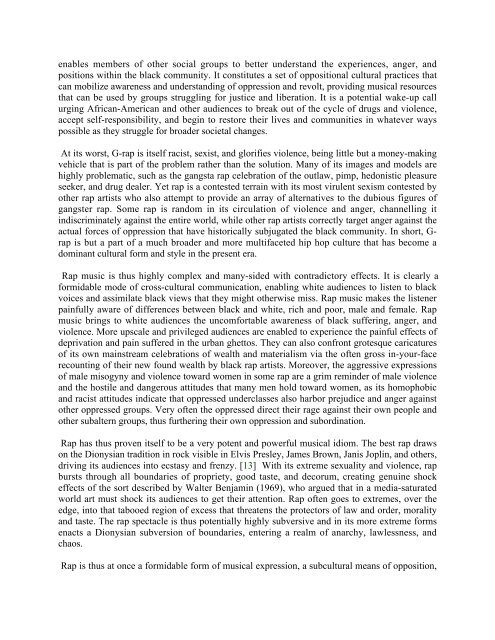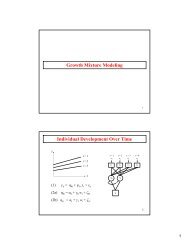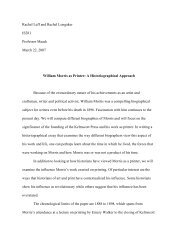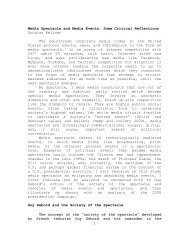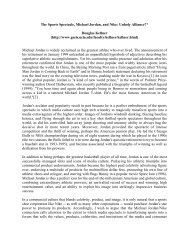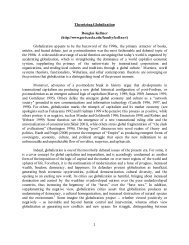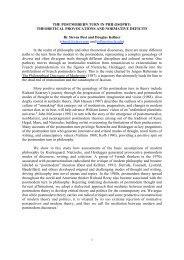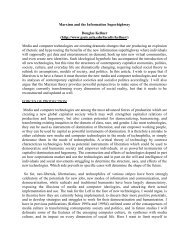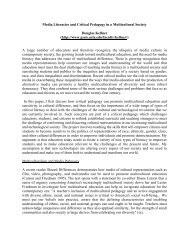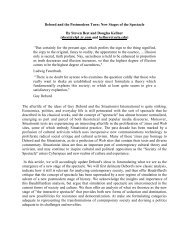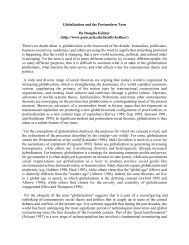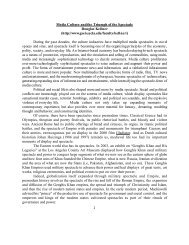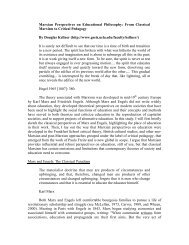Rap, Black Rage, and Racial Difference Steven Best and ... - UCLA
Rap, Black Rage, and Racial Difference Steven Best and ... - UCLA
Rap, Black Rage, and Racial Difference Steven Best and ... - UCLA
Create successful ePaper yourself
Turn your PDF publications into a flip-book with our unique Google optimized e-Paper software.
enables members of other social groups to better underst<strong>and</strong> the experiences, anger, <strong>and</strong><br />
positions within the black community. It constitutes a set of oppositional cultural practices that<br />
can mobilize awareness <strong>and</strong> underst<strong>and</strong>ing of oppression <strong>and</strong> revolt, providing musical resources<br />
that can be used by groups struggling for justice <strong>and</strong> liberation. It is a potential wake-up call<br />
urging African-American <strong>and</strong> other audiences to break out of the cycle of drugs <strong>and</strong> violence,<br />
accept self-responsibility, <strong>and</strong> begin to restore their lives <strong>and</strong> communities in whatever ways<br />
possible as they struggle for broader societal changes.<br />
At its worst, G-rap is itself racist, sexist, <strong>and</strong> glorifies violence, being little but a money-making<br />
vehicle that is part of the problem rather than the solution. Many of its images <strong>and</strong> models are<br />
highly problematic, such as the gangsta rap celebration of the outlaw, pimp, hedonistic pleasure<br />
seeker, <strong>and</strong> drug dealer. Yet rap is a contested terrain with its most virulent sexism contested by<br />
other rap artists who also attempt to provide an array of alternatives to the dubious figures of<br />
gangster rap. Some rap is r<strong>and</strong>om in its circulation of violence <strong>and</strong> anger, channelling it<br />
indiscriminately against the entire world, while other rap artists correctly target anger against the<br />
actual forces of oppression that have historically subjugated the black community. In short, Grap<br />
is but a part of a much broader <strong>and</strong> more multifaceted hip hop culture that has become a<br />
dominant cultural form <strong>and</strong> style in the present era.<br />
<strong>Rap</strong> music is thus highly complex <strong>and</strong> many-sided with contradictory effects. It is clearly a<br />
formidable mode of cross-cultural communication, enabling white audiences to listen to black<br />
voices <strong>and</strong> assimilate black views that they might otherwise miss. <strong>Rap</strong> music makes the listener<br />
painfully aware of differences between black <strong>and</strong> white, rich <strong>and</strong> poor, male <strong>and</strong> female. <strong>Rap</strong><br />
music brings to white audiences the uncomfortable awareness of black suffering, anger, <strong>and</strong><br />
violence. More upscale <strong>and</strong> privileged audiences are enabled to experience the painful effects of<br />
deprivation <strong>and</strong> pain suffered in the urban ghettos. They can also confront grotesque caricatures<br />
of its own mainstream celebrations of wealth <strong>and</strong> materialism via the often gross in-your-face<br />
recounting of their new found wealth by black rap artists. Moreover, the aggressive expressions<br />
of male misogyny <strong>and</strong> violence toward women in some rap are a grim reminder of male violence<br />
<strong>and</strong> the hostile <strong>and</strong> dangerous attitudes that many men hold toward women, as its homophobic<br />
<strong>and</strong> racist attitudes indicate that oppressed underclasses also harbor prejudice <strong>and</strong> anger against<br />
other oppressed groups. Very often the oppressed direct their rage against their own people <strong>and</strong><br />
other subaltern groups, thus furthering their own oppression <strong>and</strong> subordination.<br />
<strong>Rap</strong> has thus proven itself to be a very potent <strong>and</strong> powerful musical idiom. The best rap draws<br />
on the Dionysian tradition in rock visible in Elvis Presley, James Brown, Janis Joplin, <strong>and</strong> others,<br />
driving its audiences into ecstasy <strong>and</strong> frenzy. [13] With its extreme sexuality <strong>and</strong> violence, rap<br />
bursts through all boundaries of propriety, good taste, <strong>and</strong> decorum, creating genuine shock<br />
effects of the sort described by Walter Benjamin (1969), who argued that in a media-saturated<br />
world art must shock its audiences to get their attention. <strong>Rap</strong> often goes to extremes, over the<br />
edge, into that tabooed region of excess that threatens the protectors of law <strong>and</strong> order, morality<br />
<strong>and</strong> taste. The rap spectacle is thus potentially highly subversive <strong>and</strong> in its more extreme forms<br />
enacts a Dionysian subversion of boundaries, entering a realm of anarchy, lawlessness, <strong>and</strong><br />
chaos.<br />
<strong>Rap</strong> is thus at once a formidable form of musical expression, a subcultural means of opposition,


